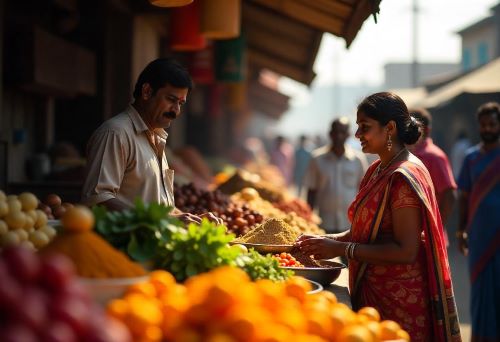India continues to battle stubbornly high food inflation, despite global trends indicating stabilization. According to the Economic Survey presented in Parliament, extreme weather events are one of the primary reasons behind the sustained rise in food prices.
Key Highlights of India’s Food Inflation
- Erratic weather patterns impact crop production
- Horticulture crops like onions and tomatoes suffer massive losses
- Extreme weather events surge, as per IMD reports
- Government plans long-term measures to control inflation
Extreme Weather Events Causing Severe Crop Damage
One of the major reasons behind India’s persistent food inflation is the rising frequency of extreme weather events.
Reports from the India Meteorological Department (IMD) and Centre for Science and Environment (CSE) confirm that heatwaves, unseasonal rainfall, and unexpected cold spells have severely impacted agricultural output.
1. Heatwaves and Unseasonal Rains Affecting Crops
- In 2023-24, crop damage in key agricultural states surged due to erratic climate patterns.
- Heatwaves increased drastically, with IMD reporting that 18% of days between 2022 and 2024 experienced extreme heat conditions, compared to just 5% in 2020-21.
- Unseasonal rainfall led to flooding in farmlands, damaging crops like wheat, pulses, and vegetables.
2. Onion and Tomato Prices Skyrocket Due to Poor Harvest

- Onion and tomato production suffered heavy losses in 2023-24, leading to steep price hikes.
- Maharashtra, Karnataka, and Andhra Pradesh, the top onion-producing states, saw significant crop losses due to unseasonal rains.
- Tomato production declined as pest infestations increased, driven by unusual climate conditions.
India’s Food Inflation: A Persistent Challenge
Food inflation has remained high for the last two years, defying global trends of price stabilization. The Economic Survey suggests that India’s inflation rate has been driven largely by domestic agricultural disruptions rather than external economic conditions.
1. How Climate Change is Worsening Food Inflation
- Climate-related crop failures are reducing supply, pushing up prices of essential food items.
- Erratic monsoons and heatwaves are affecting the sowing and harvesting cycles.
- Rising temperatures are decreasing soil moisture levels, leading to lower productivity.
2. Impact of Inflation on Consumers and Farmers
- High inflation has increased food costs for Indian households, affecting purchasing power.
- Farmers are struggling with crop losses, leading to financial distress despite government aid.
- Supply chain disruptions have exacerbated price volatility, making certain food items unaffordable.
Government Strategies to Control Food Inflation
To mitigate the impact of extreme weather on food inflation, the government has proposed a multi–pronged approach focused on sustainable farming, price stabilization, and climate adaptation strategies.
1. Climate-Resilient Crops and Advanced Farming Techniques

- The government is investing in drought-resistant and flood-resistant crop varieties.
- Modern irrigation techniques such as drip irrigation and water-efficient farming methods are being encouraged.
- Research institutions are developing heat-resistant seed varieties for key crops like wheat, rice, and vegetables.
2. Strengthening Price Monitoring and Supply Chains
- The government plans to enhance price monitoring systems to prevent sudden spikes in food prices.
- Strengthening cold storage infrastructure will help reduce post-harvest losses.
- Import policies are being adjusted to stabilize the supply of essential food items when domestic production falls short.
3. Six-Year Mission to Boost Pulse Production
- To reduce dependency on imports, the government has launched a six-year mission to increase the domestic production of pulses like tur (pigeon pea), urad (black gram), and masoor (red lentil).
- The initiative includes financial incentives for farmers and investments in high-yield seed varieties.
Geopolitical and Economic Factors Influencing Food Prices
Apart from climate-related disruptions, other economic and geopolitical factors have contributed to food inflation in India.
1. Supply Chain Bottlenecks
- Delays in transportation due to logistics disruptions and fuel price hikes have raised food costs.
- Storage inefficiencies have led to wastage of perishable goods, further limiting supply.
2. Global Economic Trends and Import Dependencies
- India’s reliance on imports for essential food items like edible oils and pulses has made domestic prices vulnerable to global fluctuations.
- Currency fluctuations and international trade policies have influenced food costs.
Conclusion: The Road Ahead for India’s Food Security

India’s food inflation crisis is a multi-faceted issue driven largely by climate change, extreme weather events, and supply chain inefficiencies.
While the government has launched several initiatives to address these challenges, long-term sustainable solutions are essential to stabilize food prices and protect both consumers and farmers.
Key Takeaways
✔️ Climate change is a major driver of food inflation.
✔️ Erratic weather conditions have severely impacted food production.
✔️ Government strategies focus on resilient farming and price stability.
✔️ Investment in agricultural infrastructure is crucial for long-term food security.
With climate-resilient agricultural practices, improved market interventions, and a focus on self-sufficiency in food production, India can effectively manage food inflation and ensure food security for the future.





